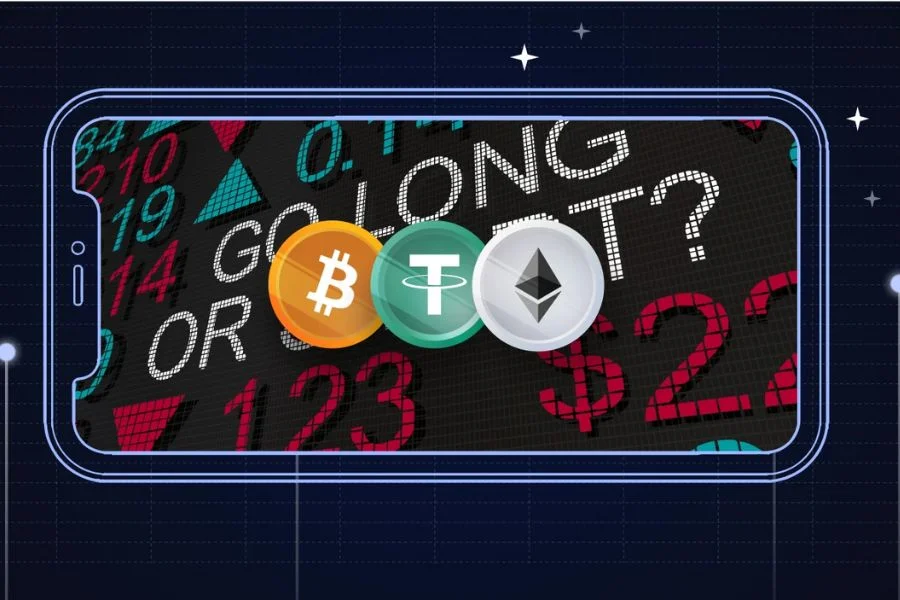If you’ve been hanging around the crypto space long enough, you’ve probably heard phrases like “I’m going long on Bitcoin futures” or “Ethereum options are heating up.” Sounds fancy, right? But for newcomers, it can feel like traders are speaking in some secret Wall Street–meets–blockchain language.
Here’s the thing: crypto derivatives aren’t as mysterious as they sound. They’re financial contracts that let you speculate on where the price of a cryptocurrency is heading — without necessarily owning it.
And yes, they can make you money. They can also wipe you out faster than you can say “liquidation.” So let’s break it down, beginner-friendly style.
Table of Contents
Crypto Derivatives Explained — The Basics
In traditional finance, derivatives are contracts whose value comes from an underlying asset — like gold, oil, or a stock. In the crypto world, that “underlying asset” could be Bitcoin, Ethereum, or any other digital token.
Instead of buying the coin directly, you trade a contract that mirrors its price movements. If the price goes the way you predicted, you profit. If not… well, you get the idea.
The main appeal? Leverage. This means you can control a large position with a smaller amount of capital. The risk? Leverage can magnify gains and losses. Think of it as trading on steroids — thrilling but potentially dangerous if you don’t know what you’re doing.
Why Trade Crypto Derivatives at All?
Good question. If you can just buy Bitcoin or Ethereum, why go for derivatives? Here’s why traders use them:
- Speculation – You can bet on prices going up (going long) or down (going short).
- Hedging – If you hold a lot of crypto, derivatives can help protect against market swings.
- Leverage Opportunities – Amplify potential returns (with the same amplification risk).
- No Need to Hold the Asset – You can trade without setting up a crypto wallet or worrying about storage.
Also Read: What Is a Hard Fork in Cryptocurrency? Real Examples You Should Know
In other words, derivatives offer flexibility — but they demand skill and discipline.
Two Main Players: Futures and Options
When people talk about crypto derivatives, they’re usually talking about futures and options. Let’s unpack both.
1. Crypto Futures – Betting on Tomorrow’s Price
A crypto futures contract is an agreement to buy or sell a cryptocurrency at a predetermined price on a specific date in the future.
Here’s how it works:
- You and another trader agree on a price for Bitcoin, say $60,000, for delivery in 30 days.
- If Bitcoin’s market price goes higher, the buyer profits. If it drops, the seller wins.
- Most crypto futures are settled in cash (or crypto) — you’re not exchanging physical Bitcoin.
Types of Crypto Futures:
- Standard Futures – Have an expiry date.
- Perpetual Futures – No expiry date; they stay open until you close them. These are super popular in crypto.
Why people like them: Futures let traders profit in both bull and bear markets. But remember — big price swings + leverage = potentially huge wins or losses.
2. Crypto Options – The Right, Not the Obligation
An option gives you the right — but not the obligation — to buy or sell a crypto asset at a set price before a certain date.
Two types here:
- Call Options – Bet that the price will go up.
- Put Options – Bet that the price will go down.
With options, you pay a premium to get that right. If the trade goes your way, you exercise it. If not, you just let it expire and lose the premium you paid — nothing more.
Options are great for risk management. They let you define your maximum loss upfront, unlike futures, where losses can spiral quickly if you’re not careful.
Key Differences Between Futures and Options in Crypto
| Feature | Futures | Options |
| Obligation | Must settle the contract | Can choose to exercise |
| Risk | Potentially unlimited | Limited to premium paid |
| Leverage | High leverage possible | Generally lower leverage |
| Market Direction | Long or short | Call (up) or Put (down) |
If you’re new, options may feel safer. Futures are more aggressive — which is why they attract thrill-seekers.
Also Read: Altcoins to Watch in 2025: Underrated Projects That Could Explode
The Risks You Can’t Ignore
Trading crypto derivatives isn’t just about potential profits — it’s also about understanding the downside.
- Leverage Risk – Using 10x leverage means a 10% market move can wipe out your position.
- Volatility – Crypto is already unpredictable; derivatives add another layer of risk.
- Liquidation – Exchanges will automatically close your position if your margin falls below the required level.
- Complexity – Without proper understanding, it’s easy to make costly mistakes.
If you’re starting, think of derivatives like a sharp kitchen knife — extremely useful but dangerous if you’re not careful.
Where to Trade Crypto Futures and Options
Many major exchanges now offer derivatives trading, including:
- Binance – One of the largest futures markets.
- Bybit – Popular for perpetual futures and leverage.
- Deribit – Known for advanced options trading.
- OKX – Offers both futures and options.
Before signing up, ensure the platform is regulated in your jurisdiction and has a proven track record for security.
Also Read: How Token Burns Affect Cryptocurrency Prices: Explained Simply
Tips for Beginners Before Diving In
- Start Small – Test with small amounts to understand the mechanics.
- Avoid Excessive Leverage – Just because 100x leverage exists doesn’t mean you should use it.
- Have a Strategy – Don’t trade based on impulse or social media hype.
- Manage Risk – Set stop-loss orders and know when to walk away.
- Keep Learning – Market conditions and tools evolve fast in crypto.
Conclusion
Crypto derivatives — whether futures or options — can be powerful tools for traders looking to profit from market movements or protect their portfolios. But they’re not beginner playgrounds. They require strategy, discipline, and an understanding of the risks involved.
If you treat them as high-risk, high-reward instruments and approach them with a solid plan, they can be an exciting part of your trading toolkit. If you treat them like a casino bet, well… the house (and the market) usually wins.




